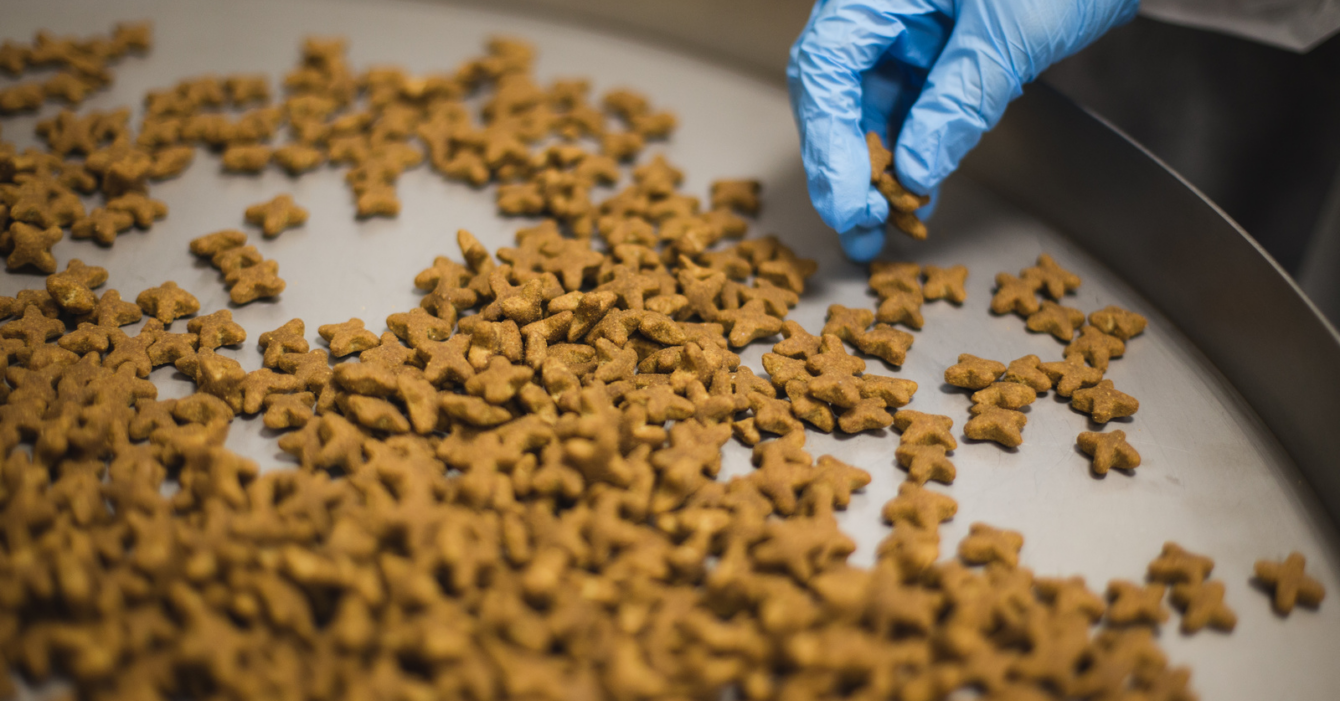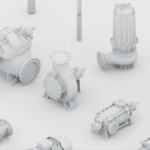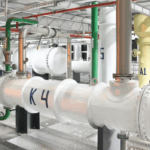In the last article, we looked at the preliminary step of manufacturing raw materials. Today we will talk about how to properly prepare wet animal feed.
Extruders. The extrusion unit is used in a production line for the production of wet pet food above a steam tunnel conveyor belt. This device is designed to form strips/bands or bars from the emulsion for further cooking in a continuous process. For the extrusion process, the emulsion temperature must be at least +5°C. The emulsion is pumped into the extruder using the mono-pump of the emulsion hopper. This pump creates a slight overpressure in the extruder head, which forces the emulsion onto the die. As the emulsion passes through the die disc, it is moulded into harnesses of the required size. Thanks to the quick-release system, the extrusion system's die disc can be easily removed and replaced. The final consistency and shape of the product mainly depends on the emulsion specifications.
Steam tunnels. In the 1980s, Selo delivered the first steam tunnel for the production of wet animal feed. This innovation triggered a major change in the feed industry. Naturally, the steam tunnel has undergone further improvements and is now a modern, high-tech system for wet feed production. The steam tunnel is used not only by well-known manufacturers around the world, but also by medium and small companies. This equipment is hygienic, efficient, economical and therefore affordable for many producers.
The steam tunnel plant is designed to process emulsion into kibble for pets. The emulsion is cooked with condensed steam as it passes through the tunnel. The speed of the process belt and the steam supply are adjusted according to the required characteristics of the cooked product. The exact cooking time depends on the characteristics of the raw material. The steam tunnel is designed to heat the emulsion from +5°C to ±92°C internal temperature. The main elements of the tunnel are two steam chambers (casings), between which a process belt continuously passes. Steam saturation is achieved by water shutters located along the tunnel. The belt is surrounded by two steam chambers. The upper cover of the steam tunnel is lowered directly over the emulsion, ensuring correct steam flow along the tunnel with product contact. The top cover can be raised manually, thereby adjusting the height above the emulsion passing along the belt. Heat is applied to the product from both sides. The steam injected through the top cover condenses on the product surface and heats the emulsion. The steam injected under the process belt condenses on the belt and heats the emulsion from below.
Advantages of Selo steam tunnels:
- High performance, but also suitable for small-scale production
- Various software configurations available: precise heating settings for products with unique specifications
- Optional: possibility of using paint systems
- High quality pet food with preserved taste and colour
In addition to steam tunnels for the production of pet food, Selo also offers hygienic and attractive packaging for your pet food products.
Cooling conveyors
The harnesses coming out of the steam tunnel are cooled by ambient air, which is forced by fans. The air is fed directly to the product. After cutting the harnesses, the pieces are also cooled on a cooling conveyor.
Advantages:
- Hygienic design
- Mesh belt for optimum air transfer
- High cooling efficiency
- Easy to clean (with water)
- Ease of access
The cutting unit is designed to cut harnesses welded in a steam tunnel and in a continuous flow to a specified length. After exiting the steel belt of the steam tunnel, the welded harnesses are fed to the receiving conveyor of the cutting machine. all made of stainless steel. The shaft speed is regulated by a frequency controller. The length of the product to be cut is set by the number of shaft revolutions. The cutting unit is adjustable at an angle (0° / 45°), which allows cutting pieces at an angle of 90° - 45°. The scraper and the counter knife always remain in the same position relative to each other, and the cutter rotates without colliding with the counter knife. The cutter is equipped with replaceable blades made of hardened metal. A small conveyor belt is located between the steel belt of the steam tunnel and the tapping unit. The harnesses are guided by this belt directly to the cutting unit, where they are cut into pieces. Only a minimal amount of product remains on the scraper.
Advantages:
- High speed
- Uniform transport
- Variable cutting length
- Adjustable cutting angle
Sauce production
The sauce can be produced in batches. Water is pumped into a container, then heated with steam and circulated by a pump. Pre-weighed dry materials are added manually and mixed with water. When ready, the sauce is pumped into a storage tank, where the mixture is continuously circulated. From the buffer tank, the sauce is pumped into the module for mixing the pieces with the sauce in a certain proportion. The produced and steam-tunneled slices and sauce must be mixed according to the required specification. This is done by means of a single or double filling system.
Single filling system
In the single-fill system, the sauce and chunks are mixed in a special container before being packed, which can be done in pallets, jars or bags.
Double filling system
In the dual system, the dispensing of slices and sauce is separated. The slices are dosed using a multi-head dosing unit and the sauce by a volumetric dosing system. Packaging can be done in pallets, jars or bags.



